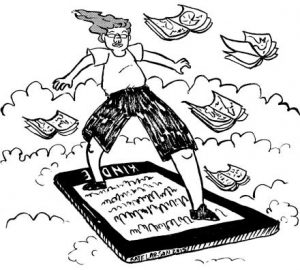
When New Yorker magazine recently became available electronically, I immediately subscribed and downloaded the first issue onto my new Kindle Voyager e-book reader. I clicked right in, sticking to my standard procedure: ignoring all the brilliant, insightful articles in favor of those single-panel cartoons which have always been a welcome relief at the end of weeks that lately have been far too long.
Well, something curious happened. Several of the cartoons landed with a thud. The punchlines zipped right past me, which elicited some serious head-scratching. What was going on here?
Oh, I had no problem finding the easy laughs, like the one in the medieval guard chastising his buddy, “I’ve asked you not to use the siege tower to meet women,” or the Sumo wrestler bear-gripping his opponent while whispering, “Full disclosure—I really need this hug.” But I wasn’t sure about the guy telling his wife, “The utility bills for my secret other life are going through the roof,” or the patient being wheeled out of the operating room, muttering, “The doctor didn’t make it.” I squinted at those, confused. Then it happened a few more times.
Maybe there was fallout in funneling a magazine’s content into a six-inch window on a device that, well, actually, did balance quite nicely in the L-shaped crook of my fingers as I lay in bed reading. Which is why I’d bought the thing in the first place. No more weighty, flapping, dust-emitting pulp. Now I had something the size of about four graham crackers that could hold every book and magazine I would ever want to read.
I tapped over to the New Yorker’s short fiction, which had always been a little highbrow for my plebeian taste, and discovered more surprise. I was engaged, grinning away, fully in. Somehow the Kindle had shifted reality. How? The mysteries were multiplying.
Over the next nights, I fell hard for the device, kvelling at the quality of its print-like 300-ppi e-Ink words. I tapped and swiped and read, and tapped and swiped and read more, mining many little pleasures I found on that somewhat small screen.
But there was deception in that display, too. Sure, you knew a book or magazine was in there, somewhere — the way you know the Himalayas are on the other side of the globe. But without the physical mass, you just didn’t feel quite as sure. Or assured. Trust entered into the equation.
Even the magazine’s length was squirrelly and indeterminate. The number of pages swelled or receded depending on your choice of font. Content often seemed to be on the move, in flux, based on ever-changing options. Yet, at the same time, the words stayed exactly the same.
If a printed New Yorker was a mountain, then the e-version was a river. A Kindle ad I saw quoted Steinbeck, “We do not take a trip; it takes us,” nailing it.
Wide-eyed, I tapped on. Who would have thought that the turn of a page could be accompanied by a tiny vibration for a comforting hint of physicality (Did I really just feel that?). Or that you could view the highlighted passages of other readers of the same book you were reading? Or that it could reach up into the cloud to snatch sample chapters and Wikipedia articles while helpfully denying you access to Facebook and email. Oh, technology! Oh product designers!
Finally, I sussed out the cartoon mystery. The ‘toons, those welcoming islands of relief which had always reliably anchored the pages in the printed New Yorker‘s text-dense waters, were all grouped together at the end in the e-version, absent the familiar surrounding text, and therein lay the problem.
I had been compensating, unconsciously, imagining the missing print around them, which was throwing me off my funny bone. The magazine’s bedrock cartoon-copy relationship was history. That distraction had tweaked me. Stubbornly I had been resisting change. (The Voyage’s sketchy graphics didn’t help much, either.)
The price of progress, I told myself. Relax. You’ve got a pretty cool device, a low $7.99 monthly subscription fee, and zero chance of adding more height to the stack of New Yorkers collecting dust in a corner of the office. Be thankful.
I did manage that and more. I made peace with the e-New Yorker. It started seeming normal. In the past, I had often been awed by the lofty patina and intimidatingly artful writing in those pages, which hinted at a wee bit of snobbishness (OK, insecurity on my part). Even that had gotten its due. In this new reality, the mag had no choice but be more open and, well, accessible. It had been touched and altered by technology, forced to yield to the leveling force that came with being available on a lowly device.
Whatever thing flows next down the river, my eyes will be wide open to forit. I’m ready for more e-surprises. Who knows what’s going to happen when I tap into the first book in my queue, the 700+ page Anna Karenina, now as light as air. Tolstoy could never have imagined this. Nor anyone, just a few years ago. It’s just the future, in its indomitable, head-spinning way, shocking you out of your comfort zone and forcing you evolve, like it or not, even if has to happen kicking and screaming. Just as it is and always will be, in this digital age.
Illustration by Kate Larson
Contact writer:
info@warrengoldie.com
www.WarrenGoldie.com
